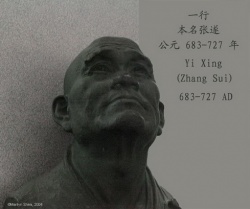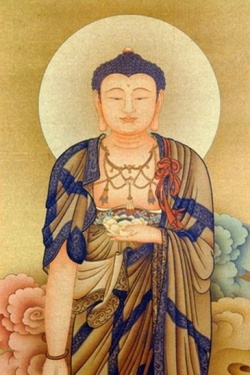I-hsing
I-hsing
一行 (683–727) (PY Yixing; Jpn Ichigyo)
A Chinese priest of Esoteric Buddhism and a disciple of Shanwuwei (Skt Shubha-karasimha). He assisted Shanwuwei in translating the Sanskrit version of the Mahavairochana Sutra into Chinese and compiled his teacher's oral teachings as The Annotations on the Mahavairochana Sutra. This commentary is highly esteemed by the True Word (Shingon) school, a school of Esoteric Buddhism in Japan. I-hsing wrote some twenty works on Esoteric Buddhism and was also well versed in the Zen (Chin Ch'an) teaching, the T'ient'ai teaching, and the vinaya (rules of monastic discipline), as well as Taoism, mathematics, astronomy, and calendrical studies. Dengyo(767-822), the founder of the Japanese Tendai school, in defense of the T'ient'ai school's doctrines, later criticized elements of I-hsing's translations and writings as containing important errors. He argued that I-hsing had incorporated key elements of the T'ient'ai school's teachings into his Chinese descriptions of the True Word doctrine and on this basis asserted the supremacy of True Word (in Japan, Chinese Esoteric Buddhism was equated with the True Word school, though the school itself originated in Japan).
Yi Xing (Chinese: 一行; pinyin: Yī Xíng; Wade–Giles: I-Hsing, 683–727), born Zhang Sui (traditional Chinese: 張遂; simplified Chinese: 张遂), was a Chinese astronomer, mathematician, mechanical engineer,and Buddhist monk of the Tang Dynasty (618–907). His astronomical celestial globe featured a clockwork escapement mechanism, the first in a long tradition of Chinese astronomical clockworks.
Science and technology
Terrestrial-astronomical survey
In the early 8th century, the Tang court put Yi Xing in charge of a terrestrial-astronomical survey. This survey had many purposes. It was established in order to obtain new astronomical data that would aid in the prediction of solar eclipses. The survey was also initiated so that flaws in the calendar system could be corrected and a new, updated calendar installed in its place. The survey was also essential in determining the measurement of the length of meridian arc. This would resolve the confusion created by the earlier practice of using the difference between shadow lengths of the sun observed at the same time at two places to determine the ground distance between them. This was the same process used by the ancient Greek Eratosthenes (276–196 BC).
Yi Xing had thirteen test sites established throughout the empire, extending from Jiaozhou in Vietnam — at latitude 17°N — to the region immediately south of Lake Baikal — latitude 50°N. There were three observations done for each site, one for the height of polaris, one for the shadow lengths of summer, and one for the shadow lengths of winter. The latitudes were deciphered from this data, while the Tang calculation for the length of one degree of meridian was fairly accurate compared to modern calculations. Yi Xing understood the variations in the length of a degree of meridian, and criticized earlier scholars who permanently fixed an estimate for shadow lengths for the duration of the entire year.
The escapement and celestial globe
Yi Xing was famed for his genius, known to have calculated the number of possible positions on a go board game (though without a symbol for zero he had difficulties expressing the number). He, along with his associate Liang Lingzan (a government official), is best known for applying the earliest known escapement mechanism to a water-powered celestial globe. However, Yi Xing's mechanical genius and achievements were built upon the knowledge and efforts of previous Chinese mechanical engineers, such as the statesman and master of gear systems Zhang Heng (78–139) of the Han Dynasty, the equally brilliant engineer Ma Jun (200–265) of the Three Kingdoms, and the Daoist Li Lan (c. 450) of the Southern and Northern Dynasties period.
It was the earlier Chinese inventor Zhang Heng who was the first to apply hydraulic power (i.e. a waterwheel and clepsydra) in mechanically-driving and rotating his equatorial armillary sphere). The arrangement followed the model of a water-wheel using the drip of a clepsydra (see water clock), which ultimately exerted force on a lug to rotate toothed-gears on a polar-axis shaft. With this, the slow computational movement rotated the armillary sphere according to the recorded movements of the planets and stars. Yi Xing also owed much to the scholarly followers of Ma Jun, who had employed horizontal jack-wheels and other mechanical toys worked by waterwheels. The Daoist Li Lan was an expert at working with water clocks, creating steelyard balances for weighing water that was used in the tank of the clepsydra, providing more inspiration for Yi Xing. Like the earlier water-power employed by Zhang Heng and the later escapement mechanism in the astronomical clock tower engineered and erected by Su Song (1020–1101), Yi Xing's celestial globe employed water-power in order for it to rotate and function properly. The historian Joseph Needham states (Wade–Giles spelling):
When the first escapement came, in +725 (AD), I-Hsing and Liang Ling-tsan arranged for two jacks to strike the hours, standing on the horizon surface of their sphere or globe.
In regards to mercury instead of water (as noted in the quote above), the first to apply liquid mercury for motive power of an armillary sphere was Zhang Sixun in 979 AD (because mercury would not freeze during winter). During his age, the Song Dynasty (960–1279) era historical text of the Song Shi mentions Yi Xing and the reason why his armillary sphere did not survive the ages after the Tang Dynasty (Wade–Giles spelling):
A jade balancing mechanism (yu heng)(ie. the escapement) is erected behind (lit. outside) a curtain, holding and resisting (chhih o) the main scoops (shu tou). Water pours down rotating the wheel (chu shui chi lun). Lower, there is a cog-wheel (chi lun) with 43 (teeth). There are also hooks, pins, and interlocking rods one holding another (kou chien chiao tsho hsiang chhih). Each (wheel) moves the next without reliance on any human force. The fastest wheel turns round each day through 2928 teeth (chhih), the slowest one moves by 1 tooth in every 5 days. Such a great difference is there between the speed of the wheels, yet all of them depend on one single driving mechanism. In precision, the engine can be compared with Nature itself (lit. the maker of all things; tsao wu che). As for the rest, it is much the same as the apparatus made (long ago) by I-Hsing. But that old design employed mainly bronze and iron, which corroded and rusted so that the machine ceased to be able to move automatically. The modern plan substitutes hard wood for these parts, as beautiful as jade...
Earlier Tang era historical texts of the 9th century have this to say of Yi Xing's work in astronomical instruments in the 8th century (Wade–Giles spelling):
One (of these) was made in the image of the round heavens (yuan thien chih hsiang) and on it were shown the lunar mansions (hsiu) in their order, the equator and the degrees of the heavenly circumference. Water, flowing (into scoops), turned a wheel automatically (chu shui chi lun, ling chhi tzu chuan), rotating it (the sphere) one complete revolution in one day and night. Besides this, there were two rings (lit. wheels) fitted round the celestial (sphere) outside, having the sun and moon threaded on them, and there were made to move in circling orbit (ling te yun hsing). Each day as the celestial (sphere) turned one revolution westwards, the sun made its way one degree eastwards, and the moon 13 and 7/19 degrees (eastwards). After 29 and a fraction rotations (of the celestial sphere) the sun and moon met. After it made 365 rotations the sun accomplished its complete circuit. And they made a wooden casing the surface of which represented the horizon, since the instrument was half sunk in it. This permitted the exact determinations of the times of dawns and dusks, full and new moons, tarrying and hurrying. Moreover there were two wooden jacks standing on the horizon surface, having one a bell and the other a drum in front of it, the bell being struck automatically to indicate the hours, and the drum being beaten automatically to indicate the quarters.
All these motions were brought about (by machinery) within the casing, each depending on wheels and shafts (lun chu), hooks, pins and interlocking rods (kou chien chiao tsho), coupling devices and locks checking mutually (kuan so hsiang chhih)(ie. the escapement). Since (the clock) showed good agreement with the Tao of Heaven, everyone at that time praised its ingenuity. When it was all completed (in +725) it was called the 'Water-Driven Spherical Bird's-Eye-View Map of the Heavens (Shui Yun Hun Thien Fu Shih Thu) or 'Celestial Sphere Model Water-Engine' and was set up in front of the Wu Chheng Hall (of the Palace) to be seen by the multitude of officials. Candidates in the imperial examinations (in +730) were asked to write an essay on the new armillary (clock). But not very long afterwards the mechanism of bronze and iron began to corrode and rust, so that the instrument could no longer rotate automatically. It was therefore relegated to the (museum of the) College of All Sages (Chi Hsien Yuan) and went out of use.
Buddhist Scholarship
Yi Xing wrote a commentary on the Mahavairocana Tantra. This work had a strong influence on the Japanese Buddhist Monk Kukai and was key in his setting up of the Shingon school of tantric Buddhism
In his honor
At the Tiantai-Buddhist Guoqing Temple of Mount Tiantai in Zhejiang Province, there is a Chinese pagoda erected directly outside the temple known as the Memorial Pagoda of Monk Yi Xing. His tomb is also located on Mount Tiantai.




